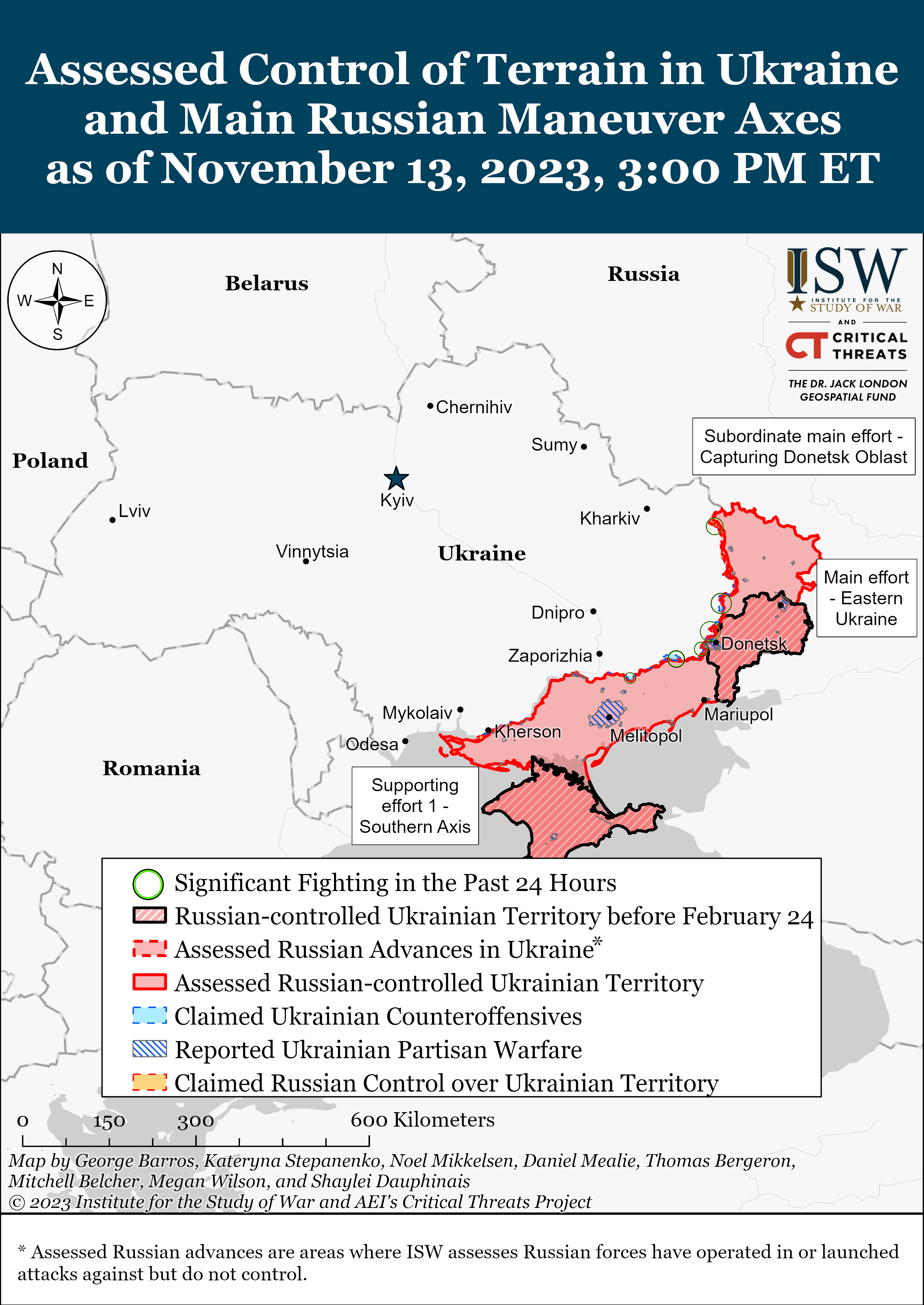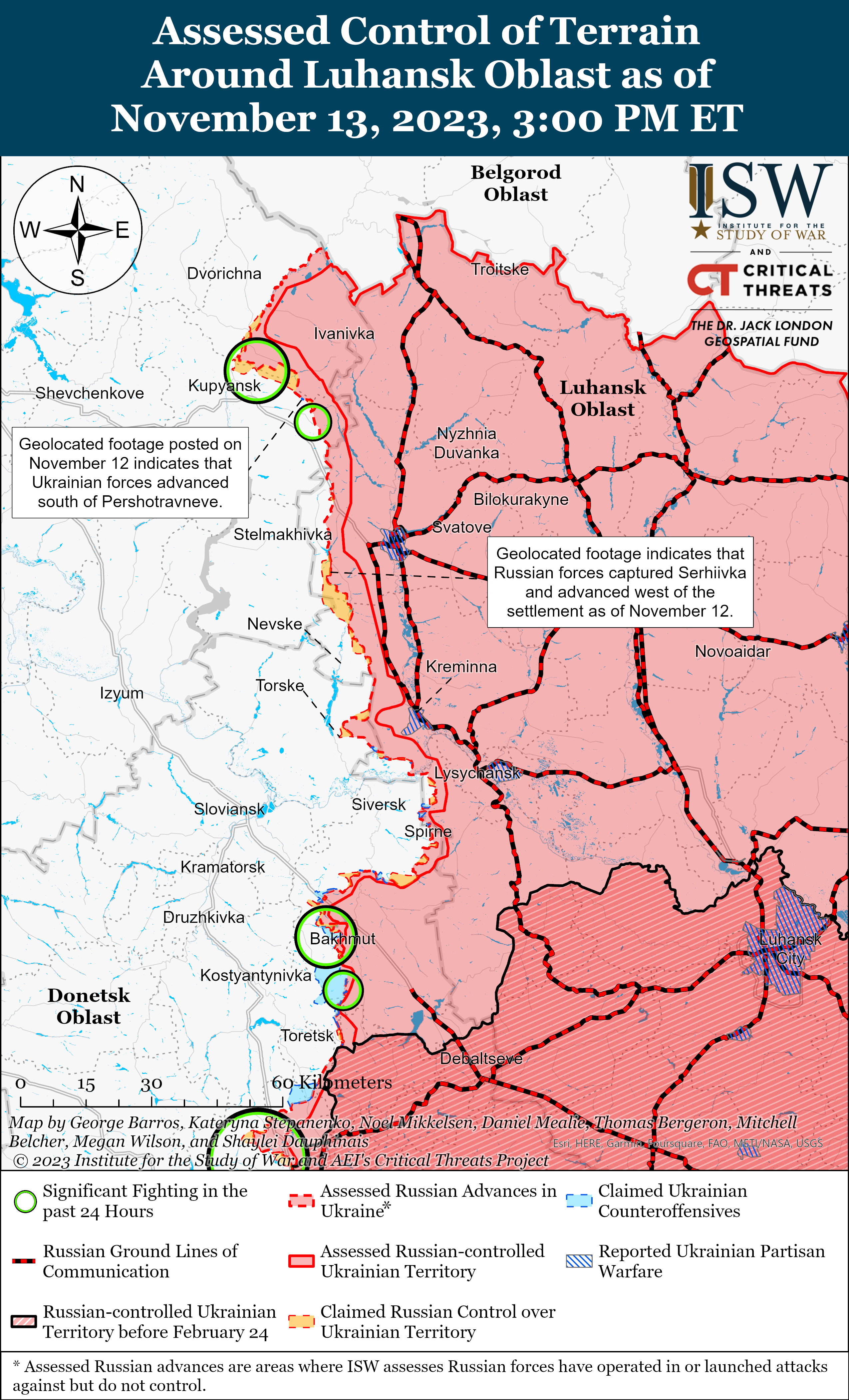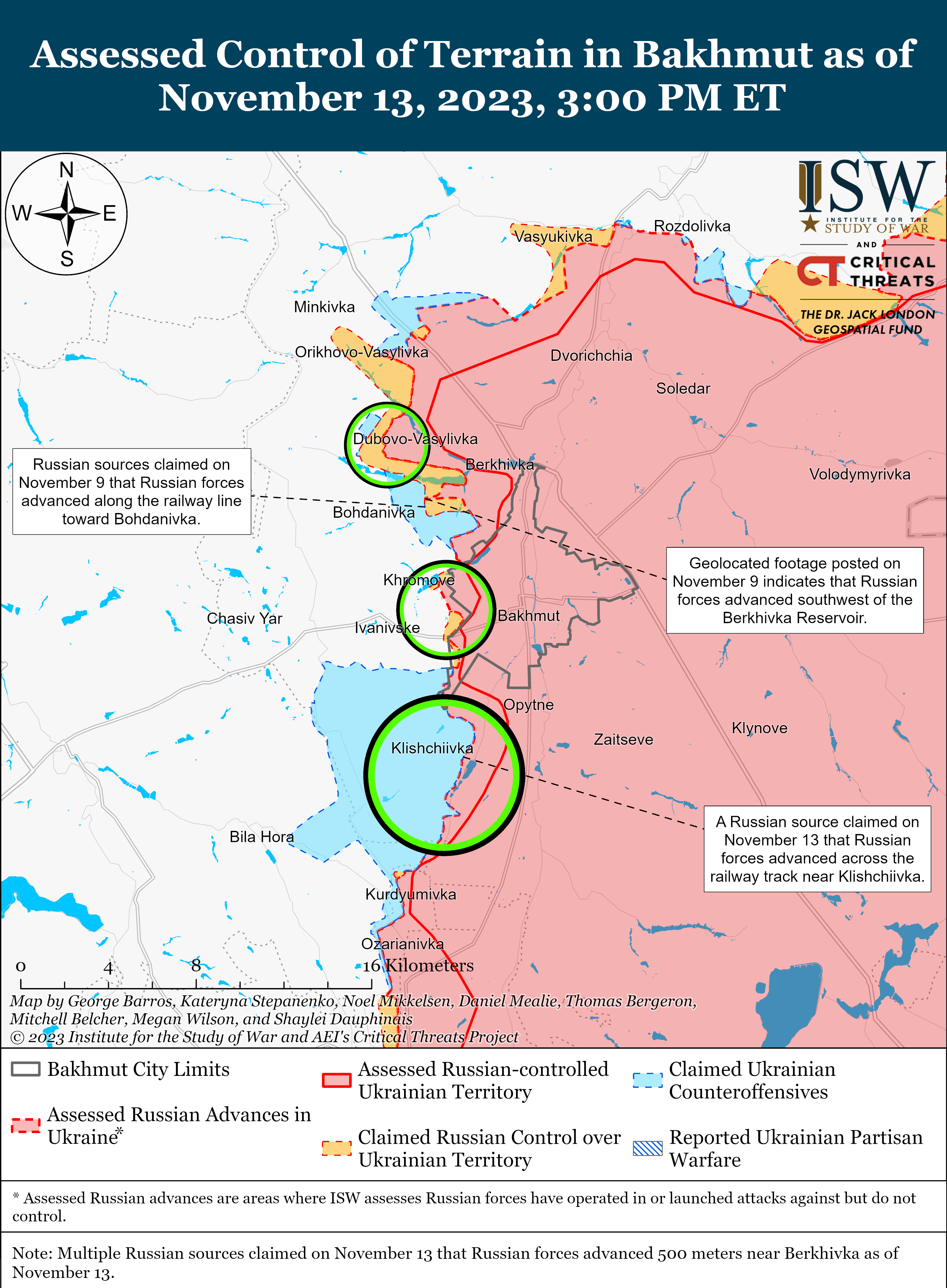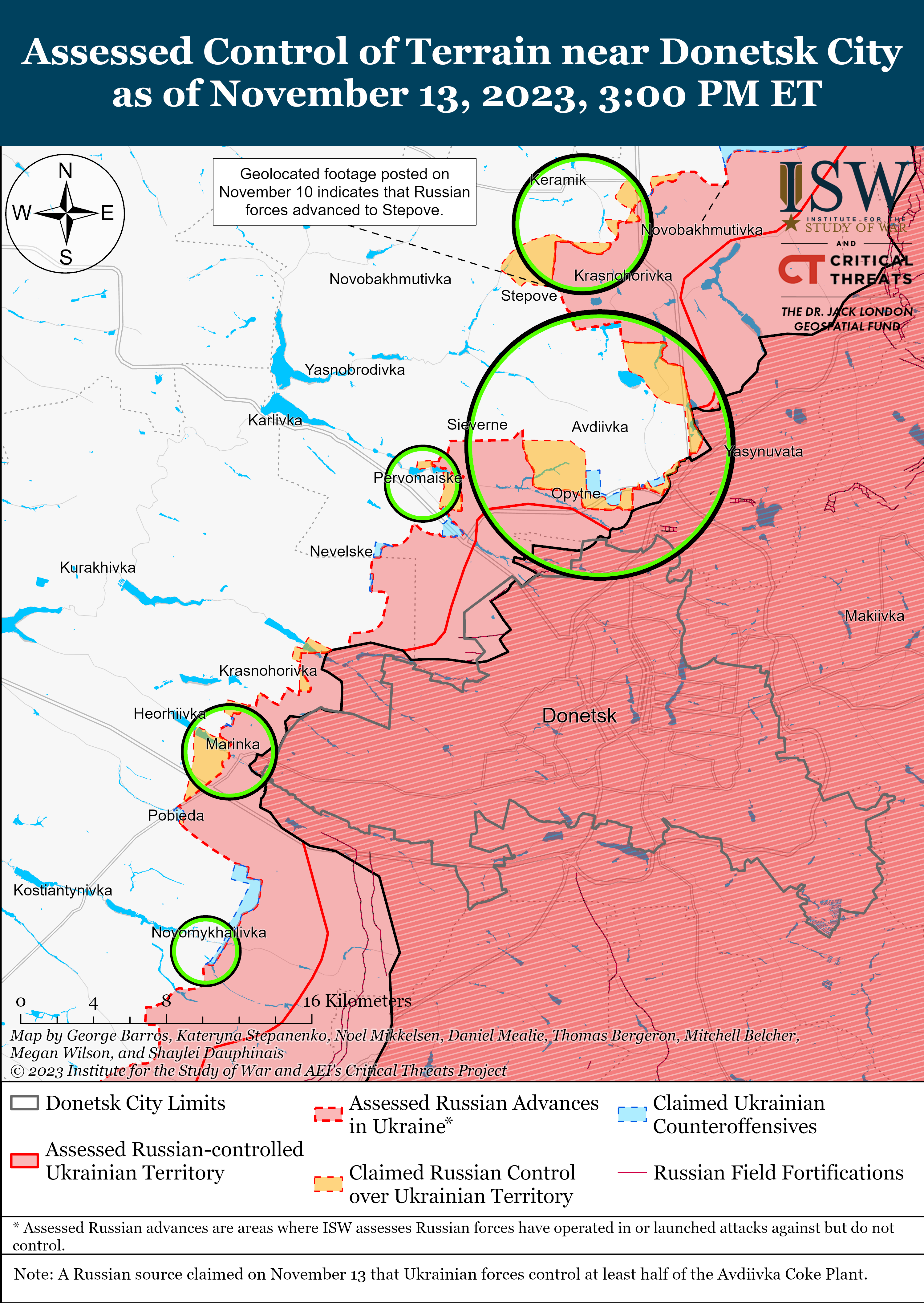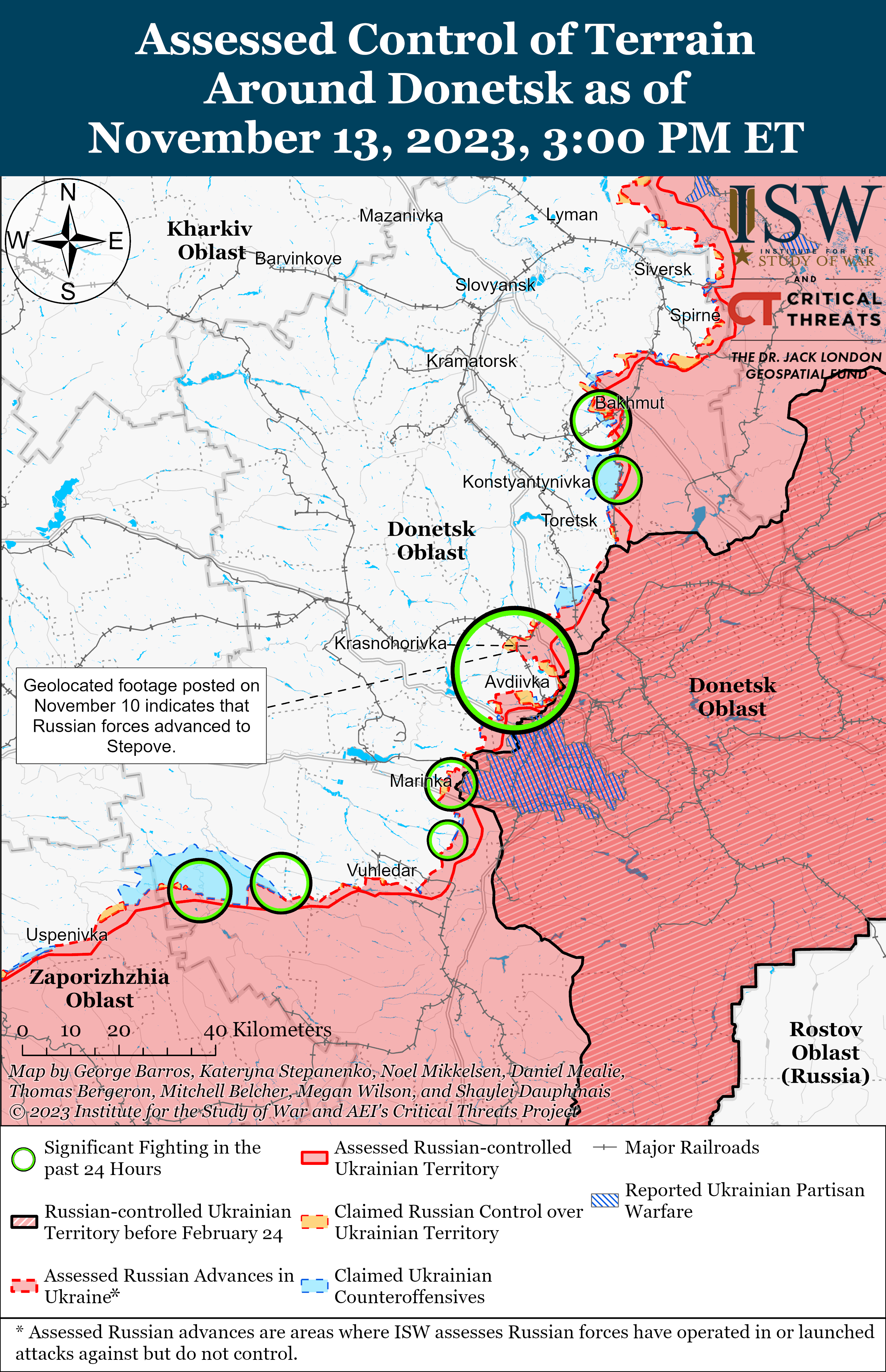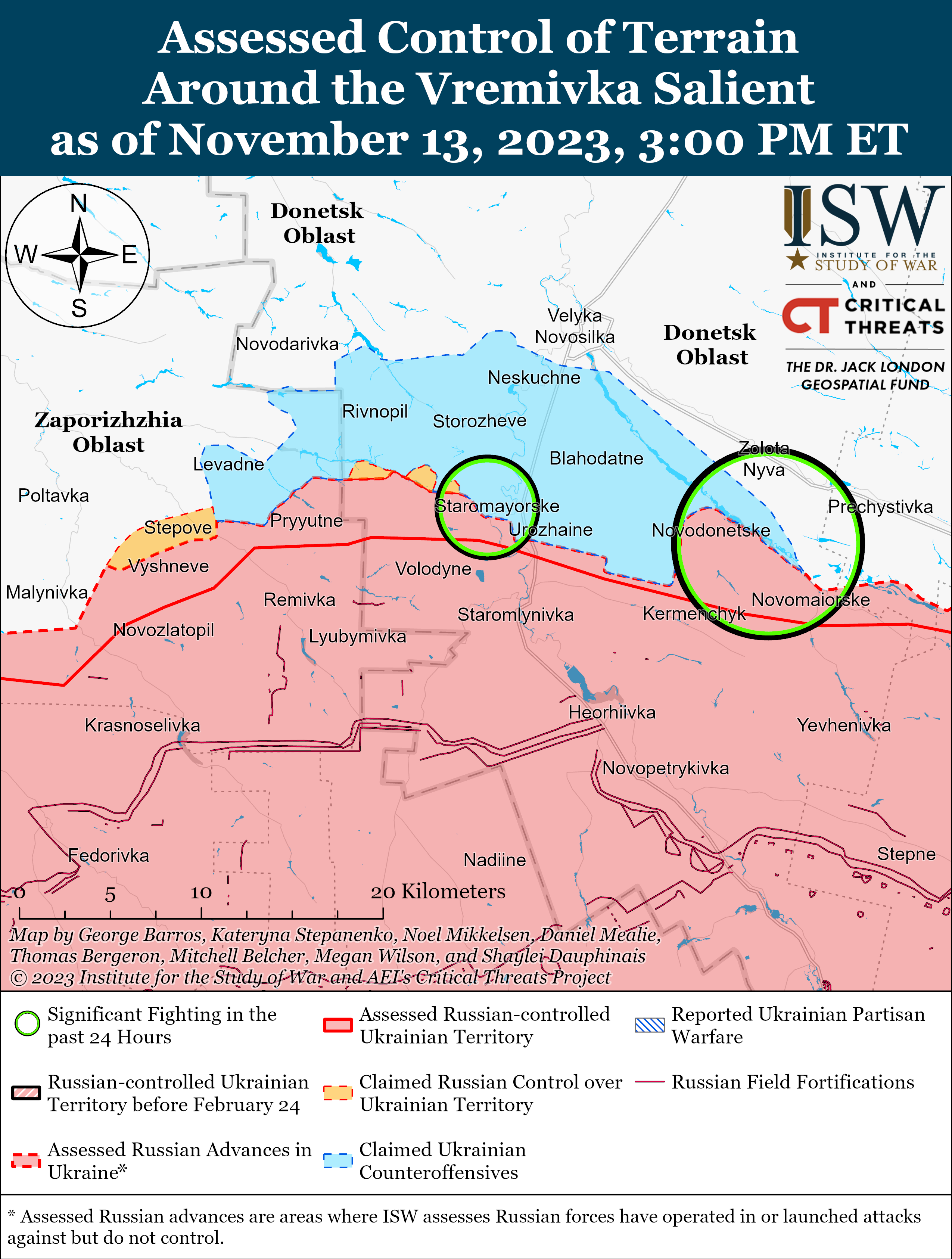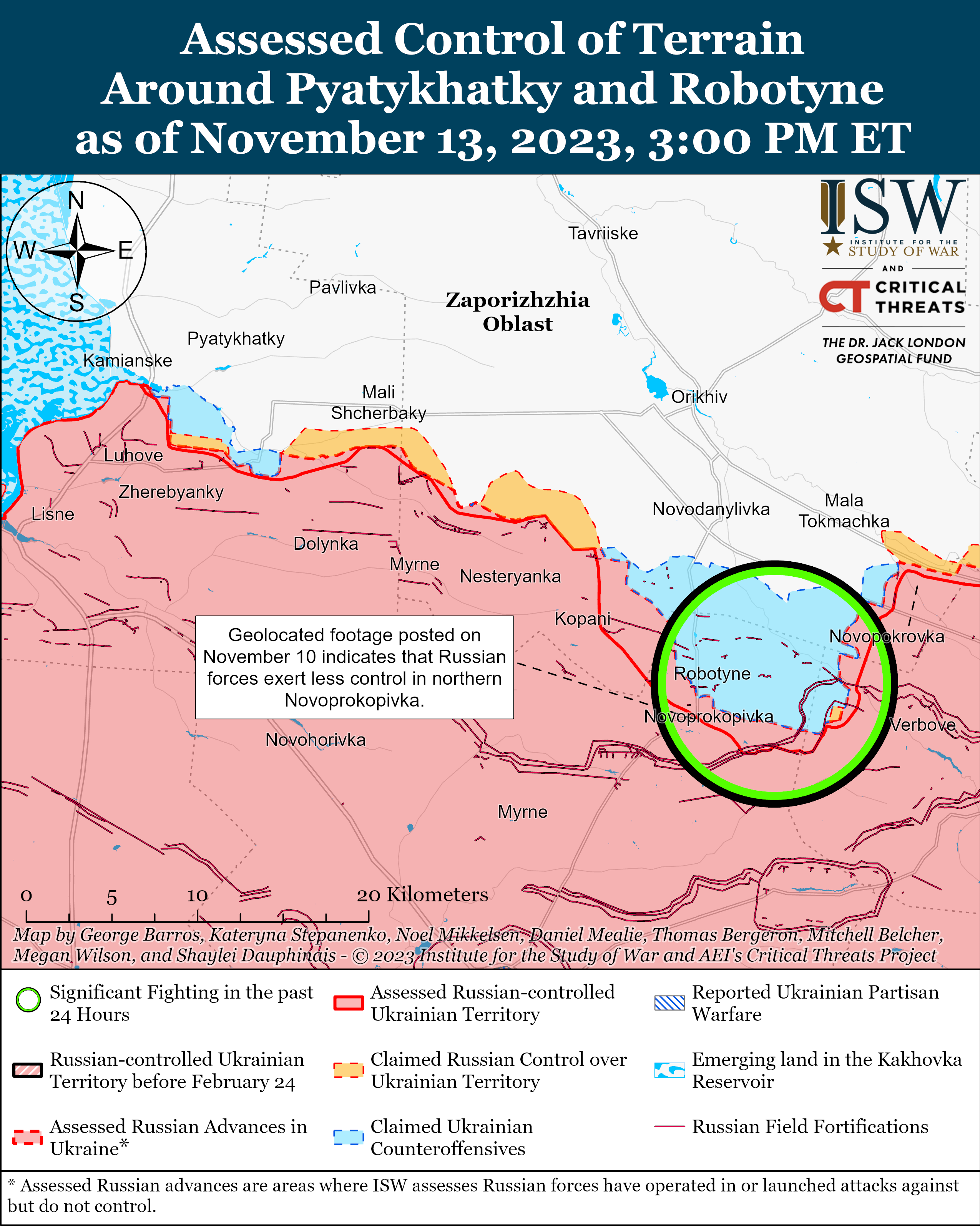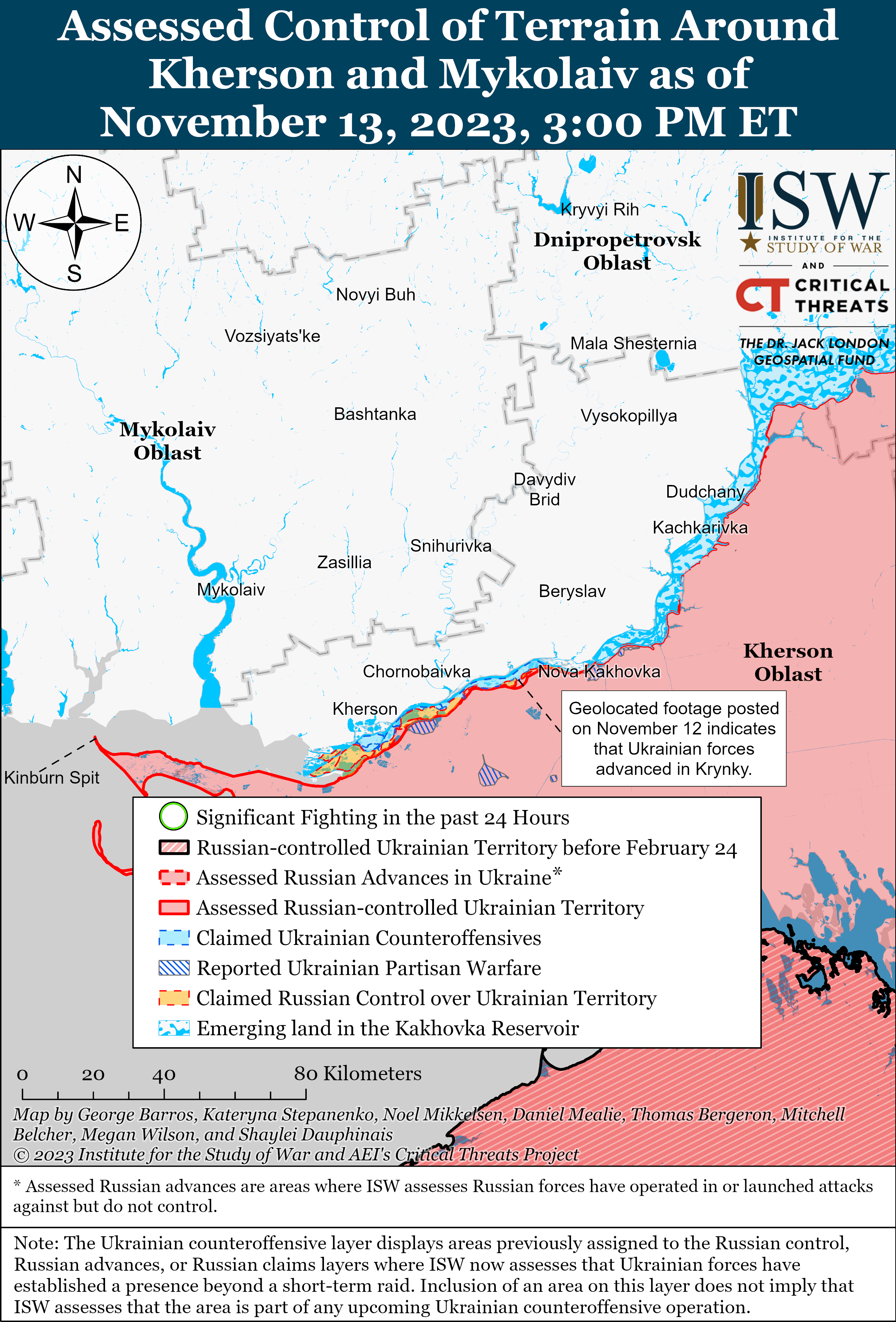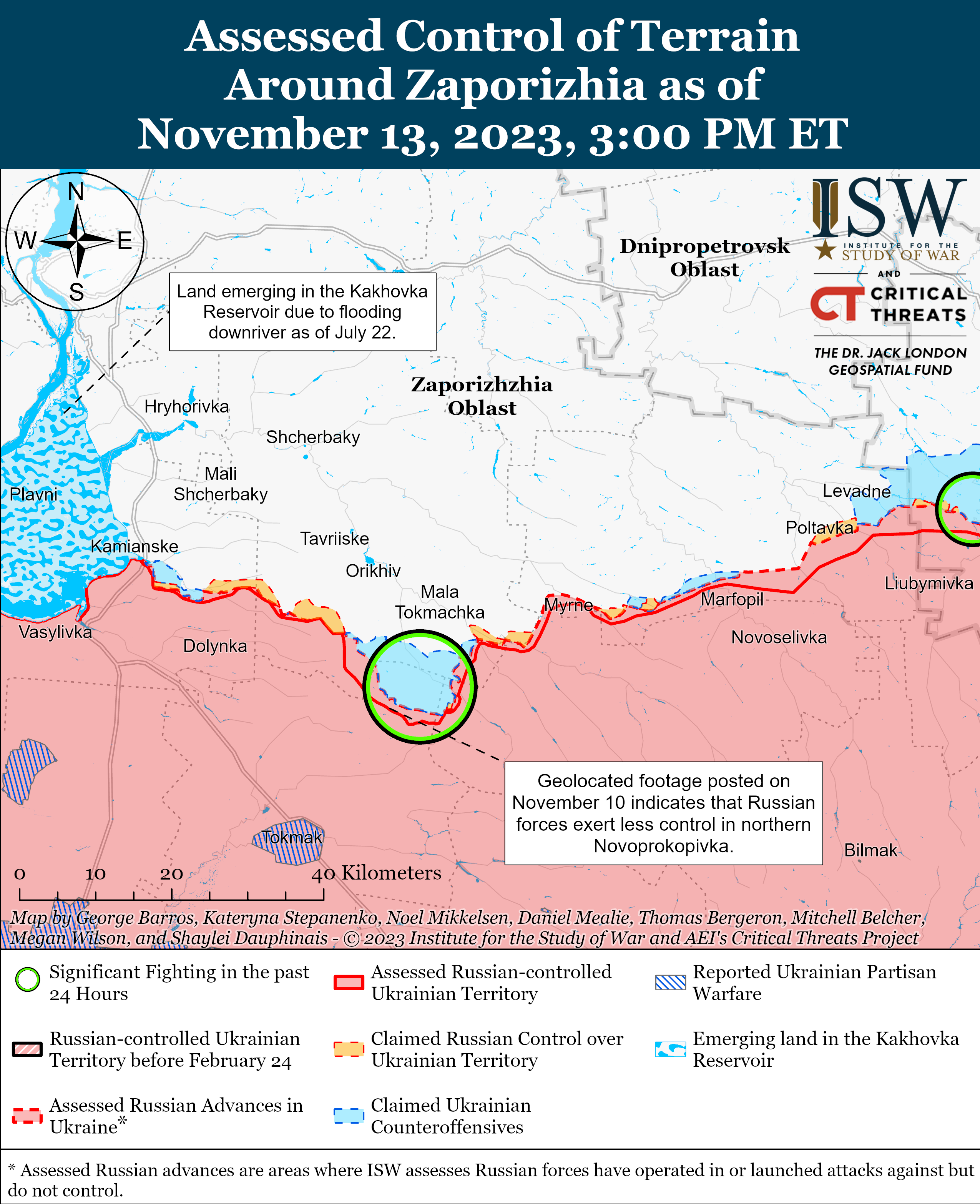Russian Offensive Campaign Assessment, November 13, 2023
Christina Harward, Karolina Hird, Riley Bailey, Nicole Wolkov, George Barros, and Frederick W. Kagan
November 13, 2023, 6:55pm ET
Click here to see ISW’s interactive map of the Russian invasion of Ukraine. This map is updated daily alongside the static maps present in this report.
Click here to see ISW’s 3D control of terrain topographic map of Ukraine. Use of a computer (not a mobile device) is strongly recommended for using this data-heavy tool.
Click here to access ISW’s archive of interactive time-lapse maps of the Russian invasion of Ukraine. These maps complement the static control-of-terrain map that ISW produces daily by showing a dynamic frontline. ISW will update this time-lapse map archive monthly.
Note: The data cut-off for this product was 1:30pm ET on November 13. ISW will cover subsequent reports in the November 14 Russian Offensive Campaign Assessment.
Russian state media released and later retracted reports about the “regrouping” of Russian forces on the east (left) bank of Kherson Oblast to positions further east of the Dnipro River, suggesting that the Russian command and/or Russian state media apparatus has failed to establish a coordinated information line for the Russian response to ongoing Ukrainian ground operations on the east bank. Kremlin press wire TASS and Russian state media outlet RIA Novosti published reports claiming that the command of the Russian “Dnepr” Grouping of Forces (currently active in east bank Kherson Oblast) decided to transfer troops to unspecified “more advantageous positions” east of the Dnipro River and that the Russian military command would transfer elements from the “Dnepr” Grouping of Forces to other directions for offensive operations following the regrouping.[1] TASS and RIA Novosti withdrew the reports within minutes and TASS later issued an apology wherein it claimed that it had “erroneously” released its report.[2] Russian state-affiliated outlet RBK reported that the Russian Ministry of Defense (MoD) called the reports of a regrouping on the east bank of Kherson Oblast “false” and a ”provocation.”[3] Kremlin spokesperson Dmitry Peskov responded to a question about the situation in Kherson Oblast by stating that only the Russian military can and should comment on the situation.[4]
The Russian MoD has not acknowledged persisting Ukrainian positions on the east bank or ongoing larger-than-usual Ukrainian ground operations in recent weeks. Russian milbloggers have increasingly reported on Ukrainian activity on the left bank, however, sharply contrasting with the continued lack of acknowledgement from Russian state media and Russian officials.[5] The Russian command has previously struggled to establish a coordinated informational approach to developments in Ukraine, particularly when the Russian command failed to set informational conditions for defeats during the Kharkiv 2022 counteroffensive.[6] Previous failures to set coordinated informational approaches have led to chaotic fractures and pronounced discontent in the Russian information space, and the Russian command risks repeating these incidents with the situation on the east bank, which has drawn notable concern from Russian ultranationalists.[7] The reports‘ references to Russian “offensives“ elsewhere on the front suggests that the uncoordinated informational approach may be more widespread than the east bank, since the Russian command has not explicitly recognized any current Russian operations in Ukraine as an offensive effort.[8]
The now-retracted reports of a Russian regrouping on the east bank of Kherson Oblast may be indicative of actual discussions taking place in the high echelons of Russian military command that may have prematurely entered the information space before being officially released by the Russian military. Russian media outlet RBK reported that the original TASS and RIA Novosti reports stated that the commander of the joint Russian group of forces in Ukraine (unnamed in the article, but in reference to Chief of the General Staff Army General Valery Gerasimov) heard and agreed with arguments from the “Dnepr” group command (also unnamed in the article, but known to be Colonel General Mikhail Teplinsky) and ordered the “Dnepr” group to redeploy and free up forces for offensive operations in other unspecified directions.[9] The suggestion that two high-ranking military commanders would have a discussion on reallocating Russian forces away from a certain sector of the front to another is not outlandish or improbable. RBK’s report further suggests that the Russian military command has assessed that the situation in Kherson Oblast is not overtly threatening to Russian forces. Despite near-constant anxiety about the Kherson direction on the part of milbloggers, the Russian military command itself seems to be preoccupied with other sectors of the front, namely the Avdiivka direction, where Russian forces are pursuing renewed offensive operations.[10] Gerasimov and Teplinsky may have weighed the costs of maintaining frontline units in Kherson Oblast with the benefits of redeploying these units to other areas of the front and decided that the current Russian grouping in rear areas of Kherson is sufficient to defend against Ukrainian operations on the east bank. Ukrainian military observer Konstantyn Mashovets remarked on November 12 that the Russian command in the Kherson direction has refused to commit to the front lines additional forces of the 70th Motorized Rifle Division (of the newly formed 18th Combined Arms Army) and 7th Air Assault (VDV) Division beyond the elements of single regiments and battalions, opting instead to maintain the remainder of these formations in near rear areas and secondary echelons of defense.[11] Mashovets noted that the Russian presence in frontline areas of Kherson Oblast is “limited.”[12] The suggestion that Russian forces have a stronger rear-area presence in Kherson Oblast largely tracks with purported discussions between Gerasimov and Teplinsky to free up these frontline elements and commit them to other areas of the front.
Alternatively, the Russian military command may have instructed state media to release and then retract these reports as part of an information operation that aims to have Ukrainian forces underestimate available Russian manpower on the east bank of Kherson Oblast. The Ukrainian Resistance Center stated on November 13 that Ukrainian officials have not observed any Russian forces withdrawing from positions on the east bank and that the TASS and RIA Novosti reports are a part of a Russian information operation to distract Ukrainian forces.[13] Ukrainian forces are very unlikely to make any operational-level decisions based on limited media reports of a Russian regrouping, however, and if the reports are a part of an information operation, they will likely fail to deceive the Ukrainian command.
It is unlikely that an outside source posing as the Russian Ministry of Defense (MoD) provided information about the reported “regrouping” of Russian forces on the left bank of Kherson Oblast to Russian state media outlets. Several Russian sources suggested that an unspecified actor posing as the Russian MoD from a fake account could have provided the information to Russian state news outlet RIA Novosti.[14] It is very unlikely that an outside actor posing as the Russian MoD could deceive Russian state media outlets as Russian state media is closely connected to Russian government bodies including the Russian MoD.
Regardless of the causes and circumstances of the TASS and RIA Novosti reports, the reaction to them suggests that events in Kherson Oblast continue to be highly neuralgic in the pro-war information space and emphasizes that the Russian media space still has not coalesced around a singular rhetorical line about what is happening on the east bank of the Dnipro. The published reports use relatively neutral language and notably do not announce a “retreat” or “withdrawal,” instead discussing a “transfer” and “regrouping.”[15] The Russian media frenzy that followed, including the immediate retraction of the statements, a direct response from the Kremlin, and emphatic milblogger refutations, reflects the fact that any mention of the Russian grouping in Kherson Oblast generates near-immediate information space neuralgia.[16] It also appears that the Russian information space has not yet determined how to discuss the operational situation on the east bank of the Dnipro, and that any inflection in the situation there can generate an informational shock. The Russian MoD falsely framed the Russian retreat from Kharkiv Oblast in early September of 2022 as a “regrouping,” and that word and general concept apparently remains highly neuralgic for the Russian information space.
Ukrainian and Russian sources noted that weather conditions are impacting the battlespace but not halting operations. Ukrainian Ground Forces Spokesperson Lieutenant Colonel Volodymyr Fityo noted on November 13 that rain and mud in Donbas impede the speed of ground maneuver advances.[17] Ukrainian 14th Mechanized Brigade Spokesperson Nadiya Zamryha stated on November 12 that fog and rain complicate both Russian and Ukrainian aerial reconnaissance efforts and lead to reduced numbers of attacks.[18] Zamryha added that the falling leaves complicate efforts to hide equipment and personnel. Ukrainian Southern Operational Command Spokesperson Captain First Rank Nataliya Humenyuk stated that Russian aviation has been less active in southern Ukraine due to weather conditions and that Russian forces are attempting to launch as many glide bombs as possible with each sortie.[19] A Ukrainian reserve officer assessed that mud will make many roads near Avdiivka impassable, complicating logistics for both sides.[20] Russian milbloggers claimed that recent heavy rains led to reduced shelling and that strong winds and rain interfere with Russian drone operations and complicate offensive operations in western Zaporizhia Oblast.[21] Russian sources also circulated footage purporting to show mud and rain filled Ukrainian trenches.[22] ISW continues to assess that fall weather conditions will decrease the tempo of Russian and Ukrainian operations but not halt them entirely, and that fighting will continue on both sides throughout the winter months as it did in the winter of 2022-2023 and in the years between 2014-2022.[23]
Ukrainian officials indicated that Ukraine will likely conduct an interdiction campaign against Russian supply routes in the upcoming winter. Ukrainian Deputy Prime Minister Iryna Vereshchuk responded on November 13 to the forecasted large-scale Russian strike series against Ukrainian critical infrastructure in the upcoming winter and stated that Ukraine is preparing air defense capabilities and needs additional air defense systems and long-range missiles, such as ATACMS, to hit Russian rear areas.[24] Ukrainian Ground Forces Spokesperson Lieutenant Colonel Volodymyr Fityo stated on November 12 that Ukrainian forces’ current main task is to disrupt Russian ground lines of communications (GLOCs) and that these disruptions, coupled with the onset of inclement weather, will “freeze” Russian offensive operations.[25] Fityo also stated on November 13 that Ukrainian disruptions of Russian GLOCs will create issues for the supply of food, water, ammunition, and winter materials to Russian forces.[26] Ukrainian forces have been conducting an interdiction campaign against Russian military infrastructure in occupied Crimea, primarily Black Sea Fleet assets, since June 2023 to degrade the Russian military’s ability to use Crimea as a staging and rear area for Russian operations in southern Ukraine, and Ukraine may intend to intensify and widen this interdiction campaign in the coming months.[27]
A Russian milblogger called on actors in the Russian information space to more widely amplify Russian strikes on Ukrainian military assets as opposed to Ukrainian strikes on Russian rear areas, indirectly highlighting a unique dynamic wherein the majority of reported Russian strikes seem to affect Ukrainian civilian objects, whereas the majority of reported Ukrainian strikes affect Russian military assets. A Russian milblogger claimed that all types of Russian units work together to identify, record, direct, and confirm Russian strikes on Ukrainian targets.[28] The milblogger complained that the Russian information space barely covers these events, which creates a “false impression of [Russian forces’] inaction.” The milblogger claimed that the Russian information space instead devotes more coverage to Ukrainian strikes on Russian territory and that Russian milbloggers have to search for information about the alleged Russian strikes on their own. The milblogger urged other milbloggers and “ordinary pro-Russian residents of Ukraine” to offer “brighter” coverage of Russian strikes on Ukrainian infrastructure and military targets in order to “create the spirit of victory in the media space.” The milblogger offered an example of the alleged insufficient coverage, claiming that Russian forces struck five unspecified Ukrainian railway junctions on an unspecified date in response to the Ukrainian operation that derailed a Russian freight train in Ryazan Oblast on November 11. The milblogger did not report on these five alleged Russian strikes previously but did report on the Ukrainian operation in Ryazan Oblast.[29] The wider Russian information space has also not reported on these alleged five retaliatory strikes, and the Russian milblogger did not specify where they got this information.[30]
Russian forces have used many of their long-range weapons to target Ukrainian critical and civilian infrastructure and have recently increased glide bomb strikes against populated areas of the west (right) bank of Kherson Oblast.[31] One critical Russian milblogger, whom Russian authorities later arrested, complained in July 2023 that the Russian strike campaign was more “retaliatory” than “operationally sound” and blamed the Russian General Staff for wasting Russian efforts on striking Ukrainian civilian infrastructure rather than military infrastructure.[32] Ukrainian President Volodymyr Zelensky stated on November 12 that Ukraine will focus on responding to the large-scale Russian series of strikes on Ukrainian critical infrastructure that are likely to occur in the winter, and Ukrainian officials have signaled their intent to strike military and energy targets within Russia and Russian-occupied areas of Ukraine.[33]
US Ambassador to Ukraine Bridget Brink stated that the 100th civilian ship departed the Black Sea corridor for civilian vessels on November 13, amid continued Russian efforts to deter usage of the corridor. Brink also stated that Ukraine has used the corridor to export 3.7 million tons of food and other goods, presumably since the first civilian vessel successfully departed from a Ukrainian port through the corridor on August 15.[34] Russian forces have continually conducted strikes on Ukrainian port infrastructure and mined water areas to disrupt and discourage civilian maritime traffic through the corridor.[35]
Former Wagner Group personnel are reportedly rejecting Russian Ministry of Defense (MoD) recruitment attempts aimed at subsuming Wagner operations in Africa. A Russian insider source claimed on November 13 that the Russian MoD, led by Russian Deputy Defense Minister Yunus-Bek Yevkurov and members of the Main Directorate of the General Staff of the Russian Armed Forces (GRU), has been attempting to recruit former Wagner personnel at the former Wagner base in Molkino, Krasnodar Krai, to Russian MoD operations in Africa since September 2023.[36] The insider source claimed that the Russian MoD is offering former Wagner personnel 110,000-ruble (about $1,200) salaries, “promising” positions and ranks, and the formation of a separate unit capable of operating in Libya, Syria, Mali, and Burkina Faso.[37] The insider source also claimed that the reported leader of Redut private military company (PMC), Konstantin Mirzoyants, denied the MoD’s offers on November 8 and claimed that the Russian MoD would not form a separate unit and that all personnel would go to Burkina Faso, which caused over 120 former Wagner personnel to reject contracts with the Russian MoD and leave Molkino.[38] ISW cannot confirm any of the insider source’s claims.
Key Takeaways:
- Russian state media released and later retracted reports about the “regrouping” of Russian forces on the east (left) bank of Kherson Oblast to positions further east of the Dnipro River, suggesting that the Russian command and/or Russian state media apparatus has failed to establish a coordinated information line for the Russian response to ongoing Ukrainian ground operations on the east bank.
- There are three hypotheses of varying likelihood for the release of the now-retracted reports of a Russian regrouping on the east bank of Kherson Oblast: They may be indicative of actual discussions taking place in the high echelons of Russian military command that may have prematurely entered the information space before being officially released by the Russian military; the Russian military command alternatively may have instructed state media to release and then retract these reports as part of an information operation that aims to have Ukrainian forces underestimate available Russian manpower on the east bank of Kherson Oblast; or an outside source posing as the Russian Ministry of Defense (MoD) provided information about the reported “regrouping” of Russian forces on the left bank of Kherson Oblast to Russian state media outlets.
- Regardless of the causes and circumstances of the TASS and RIA Novosti reports, the reaction to them suggests that events in Kherson Oblast continue to be highly neuralgic in the pro-war information space and emphasizes that the Russian media space still has not coalesced around a singular rhetorical line about what is happening on the east bank of the Dnipro.
- Ukrainian and Russian sources noted that weather conditions are impacting the battlespace but not halting operations.
- Ukrainian officials indicated that Ukraine will likely conduct an interdiction campaign against Russian supply routes in the upcoming winter.
- A Russian milblogger called on actors in the Russian information space to more widely amplify Russian strikes on Ukrainian military assets as opposed to Ukrainian strikes on Russian rear areas, indirectly highlighting a unique dynamic wherein the majority of reported Russian strikes seem to affect Ukrainian civilian objects, whereas the majority of reported Ukrainian strikes affect Russian military assets.
- US Ambassador to Ukraine Bridget Brink stated that the 100th civilian ship departed the Black Sea corridor for civilian vessels on November 13, amid continued Russian efforts to deter usage of the corridor.
- Former Wagner Group personnel are reportedly rejecting Russian Ministry of Defense (MoD) recruitment attempts aimed at subsuming Wagner operations in Africa.
- Russian forces continued offensive operations along the Kupyansk-Svatove line, near Bakhmut, near Avdiivka, west and southwest of Donetsk City, the Donetsk-Zaporizhia Oblast border area, and in western Zaporizhia Oblast and advanced in some areas of the frontline.
- Ukrainian officials continued to discuss Russian forced mobilization of Ukrainian civilians in occupied areas of Ukraine.
- Russian occupation officials continued to deport Ukrainian children to Russia under vacation schemes.
We do not report in detail on Russian war crimes because these activities are well-covered in Western media and do not directly affect the military operations we are assessing and forecasting. We will continue to evaluate and report on the effects of these criminal activities on the Ukrainian military and the Ukrainian population and specifically on combat in Ukrainian urban areas. We utterly condemn Russian violations of the laws of armed conflict and the Geneva Conventions and crimes against humanity even though we do not describe them in these reports.
- Russian Main Effort – Eastern Ukraine (comprised of two subordinate main efforts)
- Russian Subordinate Main Effort #1 – Capture the remainder of Luhansk Oblast and push westward into eastern Kharkiv Oblast and encircle northern Donetsk Oblast
- Russian Subordinate Main Effort #2 – Capture the entirety of Donetsk Oblast
- Russian Supporting Effort – Southern Axis
- Russian Mobilization and Force Generation Efforts
- Activities in Russian-occupied areas
- Russian Information Operations and Narratives
Russian Main Effort – Eastern Ukraine
Russian Subordinate Main Effort #1 – Luhansk Oblast (Russian objective: Capture the remainder of Luhansk Oblast and push westward into eastern Kharkiv Oblast and northern Donetsk Oblast)
Russian forces continued localized offensive operations along the Kupyansk-Svatove line on November 13 and made confirmed advances. Geolocated footage published on November 13 indicates that Russian forces advanced west of Volodymyrivka (19km northwest of Svatove).[39] The Ukrainian General Staff reported that Ukrainian forces repelled over 15 Russian assaults near Synkivka (9km northeast of Kupyansk), Petropavlivka (7km east of Kupyansk), Ivanivka (21km southwest of Kupyansk), Kyslivka (22km southwest of Kupyansk), and Novoyehorivka (15km southwest of Svatove).[40] Ukrainian Ground Forces Command Spokesperson Lieutenant Colonel Volodymyr Fityo stated that Ukrainian forces in the Kupyansk, Lyman, and Bakhmut directions are defending against Russian detachments comprised of convict recruits and regular Russian units comprised mainly of mobilized personnel.[41] The spokesperson for a Ukrainian brigade operating in the Kupyansk direction stated that Russian forces in the area often conduct assaults with groups of up to 10 personnel each and with four to five vehicles – squad-sized elements with limited combat power.[42]
Russian sources claimed that Ukrainian forces unsuccessfully counterattacked along the Kupyansk-Svatove-Kreminna line on November 13. The Russian Ministry of Defense (MoD) claimed that elements of the Russian Western Grouping of Forces repelled four Ukrainian assaults near Zahoruykivka (16km east of Kupyansk) and Tymkivka (19km east of Kupyansk) and that elements of the Russian Central Grouping of Forces repelled five assaults near Kreminna, Dibrova (6km southwest of Kreminna), and Bilohorivka (12km south of Kreminna).[43] Fityo stated that Ukrainian forces conduct opportunistic offensive actions to improve their tactical positions in the Kupyansk, Lyman, and Bakhmut directions.[44]
Russian Subordinate Main Effort #2 – Donetsk Oblast (Russian objective: Capture the entirety of Donetsk Oblast, the claimed territory of Russia’s proxies in Donbas)
Ukrainian forces conducted ground attacks near Bakhmut on November 13 but did not make any confirmed advances. The Ukrainian General Staff reported that Ukrainian forces continued assault operations in the Bakhmut direction.[45] The Russian Ministry of Defense (MoD) and other Russian sources claimed that Russian forces repelled Ukrainian attacks near Klishchiivka (7km southwest of Bakhmut), Kurdyumivka (13km southwest of Bakhmut), and Ivanivske (6km west of Bakhmut).[46]
Russian forces continued localized offensive operations near Bakhmut on November 13 and made a confirmed advance. Geolocated footage published on November 12 shows that Russian forces advanced west of Yahidne (2km north of Bakhmut).[47] The Ukrainian General Staff reported that Ukrainian forces repelled Russian attacks east of Klishchiivka and near Dubovo-Vasylivka (8km northwest of Bakhmut), Ivanivske, and Andriivka (10km southwest of Bakhmut).[48] Several Russian milbloggers claimed that Russian forces crossed the railway track near Klishchiivka and are consolidating control over positions in the northern part of Klishchiivka, though ISW cannot confirm this claim at this time.[49] A Russian milblogger claimed that Russian forces pushed Ukrainian forces out of Klishchiivka several days ago, while another milblogger claimed that Ukrainian forces still control Klishchiivka.[50] ISW has not observed visual evidence of a Russian advance into Klishchiivka itself. Some Russian sources claimed that Russian forces advanced in the direction of Bohdanivka (6km northwest of Bakhmut) and established new positions near the Berkhivka Reservoir (about 3km north of Bakhmut).[51] Footage published on November 13 purportedly shows elements of the Russian “Alexander Nevsky” Assault Brigade operating near Vasyukivka (15km north of Bakhmut) and elements of the Russian 331st Airborne (VDV) Regiment (98th VDV Division) operating in the Bakhmut direction.[52]
Russian forces continued offensive operations near Avdiivka on November 13 and made confirmed gains. Geolocated footage published on November 10 shows that Russian forces recently advanced to the eastern outskirts of Stepove (3km north of Avdiivka).[53] The Ukrainian General Staff reported that Russian forces conducted unsuccessful attacks southeast and south of Novokalynove (11km northwest of Avdiivka), east of Pervomaiske (11km southwest of Avdiivka) and Novobakhmutivka (13km northeast of Avdiivka), and near Avdiivka and Sieverne (6km west of Avdiivka).[54] Several Russian milbloggers claimed that fighting is ongoing near the Avdiivka Coke Plant and the waste heap in northern Avdiivka.[55] Another Russian milblogger claimed that Ukrainian forces control at least half of the Avdiivka Coke Plant and that alleged reports of Russian forces capturing the plant are false.[56] ISW has not observed Russian claims that Russian forces captured the Avdiivka Coke Plant, however. A Russian milblogger claimed that Russian forces pushed Ukrainian forces out of several unspecified positions in the industrial area on Avdiivka’s southern flank, although ISW has not observed visual confirmation of this claim.[57]
Russian milbloggers claimed that Ukrainian forces successfully counterattacked and advanced near Avdiivka on November 13. A Russian milblogger claimed that Ukrainian forces advanced to the railway station near Stepove and near the “Tsarska Okhota” restaurant immediately south of Avdiivka.[58] Another Russian milblogger claimed that Ukrainian forces unsuccessfully attacked near Krasnohorivka (5km north of Avdiivka).[59]
Russian forces continued limited ground attacks west and southwest of Donetsk City on November 13 but did not make any confirmed gains. The Ukrainian General Staff reported that Ukrainian forces repelled Russian attacks near Marinka (immediately southwest of Donetsk City) and Novomykhailivka (11km southwest of Donetsk City).[60] A Russian milblogger claimed that Russian forces gained a foothold near Novomykhailivka but are currently unable to assault Novomykhailivka itself.[61]
Ukrainian forces did not conduct any claimed or confirmed ground attacks west and southwest of Donetsk City on November 13.
Russian Supporting Effort – Southern Axis (Russian objective: Maintain frontline positions and secure rear areas against Ukrainian strikes)
A Russian milblogger claimed that Ukrainian forces resumed ground attacks in the Donetsk-Zaporizhia Oblast border area but did not make any advances on November 13. A Russian milblogger claimed that Ukrainian forces attacked north of Novodonetske (12km southeast of Velyka Novosilka) and Novomayorske (18km southeast of Veylka Novosilka) and that positional fighting is ongoing in the area.[62]
Russian forces conducted ground attacks in the Donetsk-Zaporizhia Oblast border area but did not make any claimed or confirmed advances on November 13. The Ukrainian General Staff reported that Russian forces unsuccessfully attacked south of Zolota Nyva (11km southeast of Velyka Novosilka) and near Staromayorske (9km south of Velyka Novosilka).[63] A Russian milblogger claimed that Russian forces remain active north of Pryyutne (16km southwest of Velyka Novosilka) and near Urozhaine (9km south of Veylka Novosilka), though ISW has not observed any significant Russian advances in the area in several months.[64]
Ukrainian forces continued counteroffensive operations in western Zaporizhia Oblast but did not make any claimed or confirmed advances on November 13. The Ukrainian General Staff reported that Ukrainian forces continued offensive operations in the Melitopol (western Zaporizhia Oblast) direction.[65] A Russian milblogger claimed that Ukrainian forces conducted larger-than-usual assaults with tank support north of Verbove (9km east of Robotyne) and that mutual shelling is ongoing.[66] Russian sources, including the Russian Ministry of Defense (MoD), claimed that Ukrainian forces unsuccessfully attacked near Rivne (8km west of Robotyne), Robotyne, Novoprokopivka (2km south of Robotyne), and Verbove.[67] A Russian milblogger claimed that fighting along the Kopani-Robotyne line (up to 5km northwest of Robotyne) is positional.[68]
Russian forces conducted offensive operations in western Zaporizhia Oblast but did not make any confirmed advances on November 13. Russian milbloggers claimed that Russian forces captured an unspecified fortified Ukrainian position near Robotyne.[69] A Russian source claimed that Russian forces counterattacked from Novofedorivka (21km southeast of Orikhiv) but did not specify an outcome.[70] The Ukrainian General Staff reported that Russian forces unsuccessfully attacked near Robotyne.[71]
Russian sources claimed that Ukrainian forces continued ground operations on the east (left) bank of Kherson Oblast and advanced on November 13. Russian milbloggers claimed on November 12 and 13 that Ukrainian forces maintain positions in Krynky (30km northeast of Kherson Oblast and 2km from the Dnipro River) and marginally expanded their zone of control south of the settlement.[72] A Russian milblogger claimed on November 13 that Russian forces managed to push Ukrainian forces out of unspecified positions near Krynky.[73] A Russian source claimed that Ukrainian forces conducted unsuccessful offensive maneuvers near Krynky.[74] A Russian milblogger claimed that Ukrainian forces are persistently attempting to gain a foothold near Poyma (10km southeast of Kherson City and 4km from the Dnipro River) and Pishchanivka (13km southeast of Kherson City and 3km from the Dnipro River).[75] Russian sources claimed that Russian forces are using firepower to prevent Ukrainian transfers of personnel and materiel to the east bank.[76] A Russian milblogger claimed that elements of the Russian 810th Naval Infantry Brigade (Black Sea Fleet) are operating near Krynky.[77] Ukrainian counteroffensive operations reportedly previously rendered the 810th Naval Infantry Brigade combat ineffective as of September 22.[78]
Russian forces conducted air and artillery strikes against the west (right) bank of Kherson Oblast on November 13. Ukraine’s Southern Operational Command stated on November 13 that Russian forces conducted four air strikes with 41 glide bombs against populated areas of Kherson Oblast in the past day.[79] Ukrainian Southern Operational Command Spokesperson Captain First Rank Nataliya Humenyuk stated that Russian glide bomb strikes target critical infrastructure.[80] A Russian milblogger claimed that Russian forces are constantly conducting strikes with TOS-1A thermobaric artillery systems and glide bombs on the west bank.[81]
Russian Mobilization and Force Generation Efforts (Russian objective: Expand combat power without conducting general mobilization)
Ukrainian officials continue to discuss Russian forced mobilization of Ukrainian civilians in occupied areas of Ukraine. Ukrainian Luhansk Oblast Head Artem Lysohor and the Ukrainian General Staff noted on November 12 that Russian authorities are conducting forced mobilization in Starobilsk, Luhansk Oblast, and removing mobilized Ukrainians to Krasnodar Krai for training.[82] Ukrainian Melitopol Mayor Ivan Fedorov also stated that Russian authorities are using mandatory passportization measures in occupied areas of Ukraine to distribute summonses to Ukrainian men.[83] Fedorov reported that forced mobilization has spread from small villages to bigger cities in occupied areas.[84]
Russian Technological Adaptations (Russian objective: Introduce technological innovations to optimize systems for use in Ukraine)
Russia continues efforts to enhance Iranian-produced Shahed-131/136 drones. A Russian milblogger posted footage on November 13 of a Shahed-136 drone equipped with an electro-optical seeker striking a target during testing in Iran.[85] The milblogger noted that this adaptation essentially converts Shaheds into Lancet-type drones that can travel greater distances and cause more damage.[86]
Russian state media outlet RIA Novosti reported on November 13 that Russian state-owned defense enterprise Rostec is preparing to produce the first units of the Sukhoi Su-75 “Checkmate” fifth-generation single-engine stealth aircraft.[87]
Russia continues to build out testing infrastructure for drone use. RFE/RL affiliate Idel Realii reported on November 13 that Russian Prime Minister Mikhail Mishustin signed a draft resolution establishing an “experimental legal regime” for the operation and testing of light and heavy drones in Samara Oblast.[88] The testing regime reportedly accommodates 18,000 planned flights for test drones that are produced at the production center for the national “Unmanned Aircraft Systems” program in Samara.[89]
Activities in Russian-occupied areas (Russian objective: Consolidate administrative control of annexed areas; forcibly integrate Ukrainian citizens into Russian sociocultural, economic, military, and governance systems)
Russian occupation officials continue to deport Ukrainian children to Russia under vacation schemes. Luhansk People’s Republic (LNR) head Leonid Pasechnik stated on November 12 that the Russian “humanitarian” organization “We Don’t Abandon Our Own” sent nine children from occupied Luhansk Oblast to Sochi, Krasnodar Krai for rehabilitation.[90] Pasechnik stated that the “We Don’t Abandon Our Own” organization has sent a total of 170 Ukrainian children to Sochi.[91]
Russian occupation officials continue to use social service provisions to coerce residents into receiving Russian passports and to collect personal information on residents. Kherson Oblast occupation head Vladimir Saldo stated on November 13 that updated regulations for the acquisition and use of housing certificates needed for purchasing a home or apartment will require that recipients have a Russian passport or birth certificate.[92] The new stipulations for housing certificates also likely aim to facilitate the ongoing resettlement of ethnic Russians in occupied territories in Ukraine.[93] The Kherson Oblast occupation Ministry of Internal Affairs stated on November 12 that residents will have to re-register license plates, driver’s licenses, and documentation numbers in the Russian system by 2026 and that residents will need a Russian passport to do so.[94] These re-registration measures likely aim to collect information on residents in occupied territories while also further augmenting ongoing passportization efforts.
Russian Information Operations and Narratives
Russia continues to militarize Russian children against the backdrop of the war in Ukraine. A prominent Kremlin-affiliated milblogger reported on November 13 that members of their team attended the “Time of Heroes” social event in Moscow to teach young children of Russian servicemembers “visual propaganda” via coloring books and comics.[95] The Russian Federal Agency for Youth Affairs and the Main Military-Political Directorate of the Russian Armed Forces organize the “Time of Heroes” program, which intends to instill Russian “military-patriotic” values in Russian children and youth.[96]
Prominent Russian sources are propagating various information operations aimed at disparaging the Ukrainian military and the Ukrainian military command. Various Russian sources are speculating on potential “purges” in the Ukrainian military command and amplified claims that protests against mobilization are growing in Ukraine.[97]
Chechen Republic Head Ramzan Kadyrov continues efforts to present Chechnya as stable by making claims about the purported diversity and unity of Chechen “Akhmat” Spetsnaz formations. Kadyrov posted footage on November 13 showing “Akhmat” Spetsnaz Commander Apti Alaudinov talking to “Akhmat” personnel and asking them to raise their hands to demonstrate if they are former Wagner personnel, Orthodox Christians, Muslims, or members of other faith groups.[98] Kadyrov claimed that there has never been dishonesty, disagreements, or divisions amongst “Akhmat” personnel.[99] Kadyrov is likely using this purported guise of diversity and unity amongst his notoriously brutal forces to portray “Akhmat” fighters as a powerful and effective fighting force as he continues to curry favor with the Russian high command.
Hyper-nationalist factions within the Russian space continue to seize on Russia’s relationship with migrant communities to further hardline xenophobic rhetoric against minority communities. Moscow Duma Deputy Andrey Medvedev responded on November 13 to a statement made by the Russian Commission of the Public Chamber on Interethnic and Interreligious Relations and Migration Chairperson Vladimir Zorin, who voiced his concern over the “changed tone in the socio-political discourse on the issue of migration and interethnic relations.”[100] Medvedev questioned Zorin’s “Russianness” and emphasized that Russia is ignoring “migrant problems,” concluding that Russia needs to protect Russians in Russia.[101] ISW previously assessed that the war in Ukraine is exposing tensions between Russian national identity and Russian nationalism, and the continued participation of Russian politicians in anti-migrant discourse exacerbates these apparent tensions.[102]
Significant activity in Belarus (Russian efforts to increase its military presence in Belarus and further integrate Belarus into Russian-favorable frameworks and Wagner Group activity in Belarus)
Belarusian Defense Minister Lieutenant General Viktor Khrenin signed a bilateral military cooperation agreement with United Arab Emirates (UAE) Minister of State for Defense Affairs Mohammed Ahmed al Bowardi following negotiations in Dubai on November 13.[103]
Note: ISW does not receive any classified material from any source, uses only publicly available information, and draws extensively on Russian, Ukrainian, and Western reporting and social media as well as commercially available satellite imagery and other geospatial data as the basis for these reports. References to all sources used are provided in the endnotes of each update.
[17] https://suspilne dot media/615677-zsu-znisili-ponad-20-zrazkiv-rosijskoi-tehniki-ta-bils-ak-250-vijskovih-rf-na-shodi/
[19] https://armyinform.com dot ua/2023/11/13/mynuloyi-doby-vorog-zastosuvav-ponad-40-kerovanyh-aviaczijnyh-bomb-na-pivdennomu-napryamku/
[24] https://minre.gov dot ua/2023/11/13/ekonomichna-ta-vijskova-pidtrymka-nashyh-partneriv-dopomozhe-ukrayini-uspishno-projty-najblyzhchu-zymu/
[25] https://suspilne dot media/615503-ukrainski-vijskovi-sprobuut-vimoroziti-okupantiv-perebivsi-logisticni-lancuzki-zsu/
[26] https://suspilne dot media/615677-zsu-znisili-ponad-20-zrazkiv-rosijskoi-tehniki-ta-bils-ak-250-vijskovih-rf-na-shodi/
[58] ttps://t.me/DnevnikDesantnika/4730
[80] https://armyinform.com dot ua/2023/11/13/mynuloyi-doby-vorog-zastosuvav-ponad-40-kerovanyh-aviaczijnyh-bomb-na-pivdennomu-napryamku/
[96] https://ecubip dot ru/novosti/%D1%81%D0%BE%D1%86%D0%B8%D0%B0%D0%BB%D1%8C%D0%BD%D0%BE-%D0%BF%D0%B0%D1%82%D1%80%D0%B8%D0%BE%D1%82%D0%B8%D1%87%D0%B5%D1%81%D0%BA%D0%B0%D1%8F-%D0%B0%D0%BA%D1%86%D0%B8%D1%8F-%C2%AB%D0%B2%D1%80%D0%B5%D0%BC%D1%8F-%D0%B3%D0%B5%D1%80%D0%BE%D0%B5%D0%B2%C2%BB; https://er dot ru/activity/news/edinaya-rossiya-zapustila-akciyu-vremya-geroev


